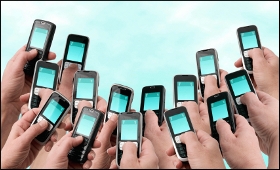|

|
12 billion mobiles in next 10 years
|
|

|
|
| Top Stories |
 |
|
|
|
Prasanto K. Roy | 08 Apr, 2013
One kilogram. That's what it weighed, the bulky prototype used for a wireless phone call by a Motorola engineer in 1973. For the real milestone 10 years later, a 790-gram Motorola DynaTAC made the first call from a commercial mobile phone, in a Mercedes in 1983. That makes the mobile 30 years old, and not the 40 that's being reported.
Since then, it's been a long road to today's smart, slim, all-colour 100-gram personal digital companion. The mobile helped India leapfrog past wireline telephony, to a personal phone for every other citizen. It's altered social behaviour. It's caused revolutions.
Mobile subscriptions grew from zero in 1983 to 12 million in 1990, and then to 6 billion in 2011. The world bought 1.75 billion mobiles in 2012. Of the 1.8 billion expected to sell in 2013, about half could be smartphones.
So how's the mobile changed in 30 years? Yes, it's now small and light, and has gone from one-line mono display to colour to high-definition. The bigger deal is that it's moved from voice to mostly data: email, browsing, apps. And from phone to personal companion. Yet the mobile is far from perfect. There are two big issues.
The first is the battery: The only reason why James Bond's wrist-watch mobiles are impractical. Ten years ago, my Nokia 6310i would last seven days on a charge. My 2013 BlackBerry Z10 struggles to last a day.
The battery hasn't kept up with the increase in data and apps use. In the voice-only era, the phone's radio (the part that sends and receives signals) would be in use for two hours in 24. In today's data age, those radios work continuously, draining batteries.
The second is congestion. Mobiles use radio spectrum, a scarce resource. The more phones fight for that spectrum, the worse our experience is: Failed and dropped calls, breaking voices.
But with over 6 billion subscriptions already there for its 7 billion people, will our planet keep up the explosive mobile-telephony growth of the past 30 years? Oh, yes!
Let's look at those subscriptions. A half-billion are in multi-SIM phones or multiple phones owned by the same person. Or in other devices such as iPads, or laptop dongles.
Another half-billion mobile users are machines. Electric meters, escalators, automobiles, security cameras, with built-in cellular modules. They auto-report readings, usage status, failures. Some, like digital doorlocks, allow remote control.
Both parts are seeing explosive growth. Users are adding mobile data devices, including tablets, laptops, connected GPS units. And by 2020, many household and office appliances, and most vehicles, will have cellular modules, for usage, status, and maintenance reporting.
All this will add at least another six billion mobile-phone subscriptions by 2020. And so we'll have 12 billion cellular devices fighting for scarce spectrum.
So here's where the mobile phone is headed in the next ten years:
Ubiquity: They'll be all around, inside appliances, cars, bicycles. These embedded modules will make up a third of 12 billion "subscriptions" by 2020.
Data-only devices will rival phones in numbers, by 2020: dongles, iPads, SIMs in laptops.
Smartphones will be 100 percent of the mobile-phone population, up from about a quarter now. Even the cheapest $30 model will be a smartphone.
The battery will struggle to keep pace with apps and displays, even with advances such as nanowire lithium-polymer. Till 2020, when we should see the next big leap in battery tech. This could be lithium-air, magnesium, fuel-cell, or something else.
Wearable wrist-watch phones will start getting into vogue by 2015, from Apple, Samsung and others, but will get really practical only by 2020, with major changes in battery tech.
Beyond 4G, the big challenge is to squeeze 12 billion devices into the same scarce spectrum. This will be met through a 5G tech that will focus less on giant leaps in raw speed, and more on efficiently using less spectrum for heavy mixed-media use.
So what will the phone look like in 2020?
Current shapes - slim, all-touch units - will continue at the low end. They'll all be smartphones, of course. At the upper end, there'll be serious, wearable phones, in wristwatches, even spectacle-frames. Spanning both ends will be heavy use of video. While, all around us, invisibly, those billions of embedded cellular modules will keep chattering.
(Prasanto K. Roy is editorial advisor at CyberMedia - @prasanto on twitter. He can be contacted at pkr@cybermedia.co.in. The views expressed in the article are personal.)
|
SEE ALSO
|
| |
|
|
|
|
|
|
|
|
|
|
|
|
|
|
| |
| Customs Exchange Rates |
| Currency |
Import |
Export |
US Dollar
|
66.20
|
64.50 |
UK Pound
|
87.50
|
84.65 |
Euro
|
78.25
|
75.65 |
| Japanese
Yen |
58.85 |
56.85 |
| As on 13 Aug, 2022 |
|
|
| Daily Poll |
 |
 |
| PM Modi's recent US visit to redefine India-US bilateral relations |
|
|
|
|
|
| Commented Stories |
 |
|
|
|
|
|
| |
|